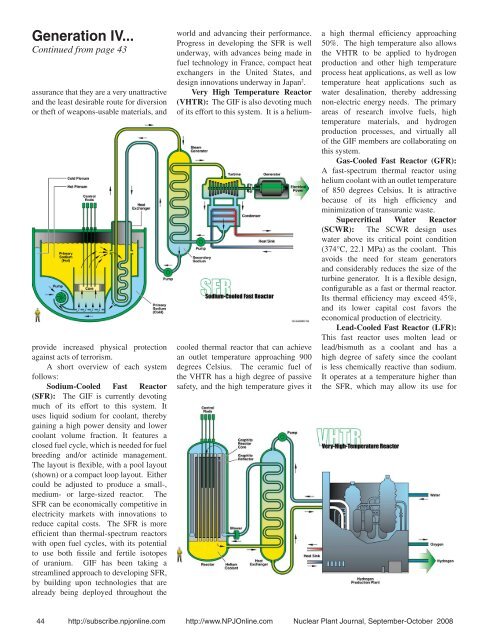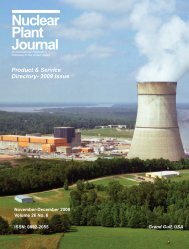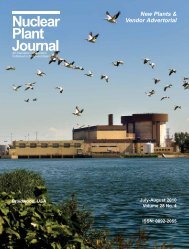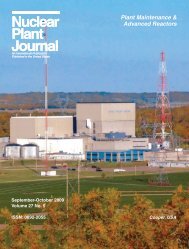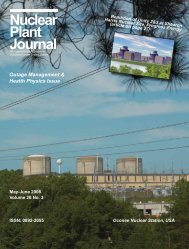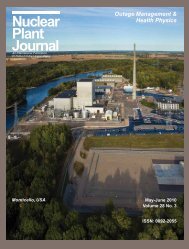Nuclear Plant Journal - Digital Versions
Nuclear Plant Journal - Digital Versions
Nuclear Plant Journal - Digital Versions
Create successful ePaper yourself
Turn your PDF publications into a flip-book with our unique Google optimized e-Paper software.
Generation IV...<br />
Continued from page 43<br />
assurance that they are a very unattractive<br />
and the least desirable route for diversion<br />
or theft of weapons-usable materials, and<br />
provide increased physical protection<br />
against acts of terrorism.<br />
A short overview of each system<br />
follows:<br />
Sodium-Cooled Fast Reactor<br />
(SFR): The GIF is currently devoting<br />
much of its effort to this system. It<br />
uses liquid sodium for coolant, thereby<br />
gaining a high power density and lower<br />
coolant volume fraction. It features a<br />
closed fuel cycle, which is needed for fuel<br />
breeding and/or actinide management.<br />
The layout is flexible, with a pool layout<br />
(shown) or a compact loop layout. Either<br />
could be adjusted to produce a small-,<br />
medium- or large-sized reactor. The<br />
SFR can be economically competitive in<br />
electricity markets with innovations to<br />
reduce capital costs. The SFR is more<br />
efficient than thermal-spectrum reactors<br />
with open fuel cycles, with its potential<br />
to use both fissile and fertile isotopes<br />
of uranium. GIF has been taking a<br />
streamlined approach to developing SFR,<br />
by building upon technologies that are<br />
already being deployed throughout the<br />
world and advancing their performance.<br />
Progress in developing the SFR is well<br />
underway, with advances being made in<br />
fuel technology in France, compact heat<br />
exchangers in the United States, and<br />
design innovations underway in Japan 2 .<br />
Very High Temperature Reactor<br />
(VHTR): The GIF is also devoting much<br />
of its effort to this system. It is a heliumcooled<br />
thermal reactor that can achieve<br />
an outlet temperature approaching 900<br />
degrees Celsius. The ceramic fuel of<br />
the VHTR has a high degree of passive<br />
safety, and the high temperature gives it<br />
a high thermal efficiency approaching<br />
50%. The high temperature also allows<br />
the VHTR to be applied to hydrogen<br />
production and other high temperature<br />
process heat applications, as well as low<br />
temperature heat applications such as<br />
water desalination, thereby addressing<br />
non-electric energy needs. The primary<br />
areas of research involve fuels, high<br />
temperature materials, and hydrogen<br />
production processes, and virtually all<br />
of the GIF members are collaborating on<br />
this system.<br />
Gas-Cooled Fast Reactor (GFR):<br />
A fast-spectrum thermal reactor using<br />
helium coolant with an outlet temperature<br />
of 850 degrees Celsius. It is attractive<br />
because of its high efficiency and<br />
minimization of transuranic waste.<br />
Supercritical Water Reactor<br />
(SCWR): The SCWR design uses<br />
water above its critical point condition<br />
(374°C, 22.1 MPa) as the coolant. This<br />
avoids the need for steam generators<br />
and considerably reduces the size of the<br />
turbine generator. It is a flexible design,<br />
configurable as a fast or thermal reactor.<br />
Its thermal efficiency may exceed 45%,<br />
and its lower capital cost favors the<br />
economical production of electricity.<br />
Lead-Cooled Fast Reactor (LFR):<br />
This fast reactor uses molten lead or<br />
lead/bismuth as a coolant and has a<br />
high degree of safety since the coolant<br />
is less chemically reactive than sodium.<br />
It operates at a temperature higher than<br />
the SFR, which may allow its use for<br />
44 http://subscribe.npjonline.com http://www.NPJOnline.com <strong>Nuclear</strong> <strong>Plant</strong> <strong>Journal</strong>, September-October 2008


